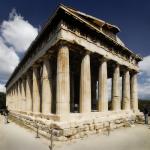|
This section contains 268 words (approx. 1 page at 300 words per page) |

|
In his poem On Nature (fifth century B.C.E.), Empe- docles draws an analogy to a common implement from daily life in the ancient world—the klepshudra or "water-catcher"—to explain how living things breathe:
Everything breathes in and out. All creatures have bloodless vessels in their flesh, extending over the surface of the body, and the skin is perforated with pores at the mouths of those vessels, keeping the blood inside but cutting an easy route for air to pass. When the liquid blood moves away from there, the air bubbles in with a violent surge; and a when the blood rushes back, the air is pushed out again. It is just as when a girl plays with a bright brass klepshudra. When she puts her beautiful hand over the mouth of the pipe and dips it into shining...
|
This section contains 268 words (approx. 1 page at 300 words per page) |

|




